Last of a five-part series.
When it comes to grade-school dances, a few touches withstand the test of time.
An explosion of paper-heart decor? Check.
Pizza and soda as refreshments? Check.
Popular line dances? Check.
But etched into the memories of adults years or decades removed from the elementary social scene is another element that’s synonymous with this rite of passage — the thrilling and fumbling terrain of childhood crushes. The Valentine’s Day dance at Sunrise Acres Elementary School doesn’t disappoint on that front either.
As the music thumps and laughter echoes throughout the cafeteria-turned-dance hall, a half circle forms around two fifth-graders. He’s wearing a yellow sweatshirt and blue jeans; she’s wearing a knee-length, green dress and black sandals. A mother draws her smartphone eye level and motions for them to pose.
The pair smile sheepishly. His right arm rises and curves gently around her shoulders — stopping just short of making any skin-to-skin contact.
Click, click, click.
Emboldened now, the boy delicately takes the girl’s hand and twirls her on the dance floor.
“Oh my god! Oh my god!” one of her friends shrieks in excitement.
They blend into the sea of students, teachers, parents and younger siblings who are shaking and gliding to the tunes blasting from speakers. The sold-out dance triggers a line outside the school by 4:30 p.m. Parents like Ronnie and Jada had postponed their romantic date nights to give their children a carefree — and technology-free — evening.
“It’s a whole different world from when I was a teenager,” the 26-year-old father says, shaking his head. “It doesn’t seem that long ago, but the world was completely different eight years ago. We were still passing notes.”
The sentiment isn’t lost on the educators who planned the second-annual dance. The $1 admission won’t thrust the school into green-filled pastures. That’s not the point.
The after-school dance is simply a chance to have fun — a word that in today’s education world sometimes gets overshadowed by more pressing academic concerns. But for a lively 90 minutes on this campus, data doesn’t matter. Nor do academic goals.
That will come soon enough. Standardized tests begin the next month.
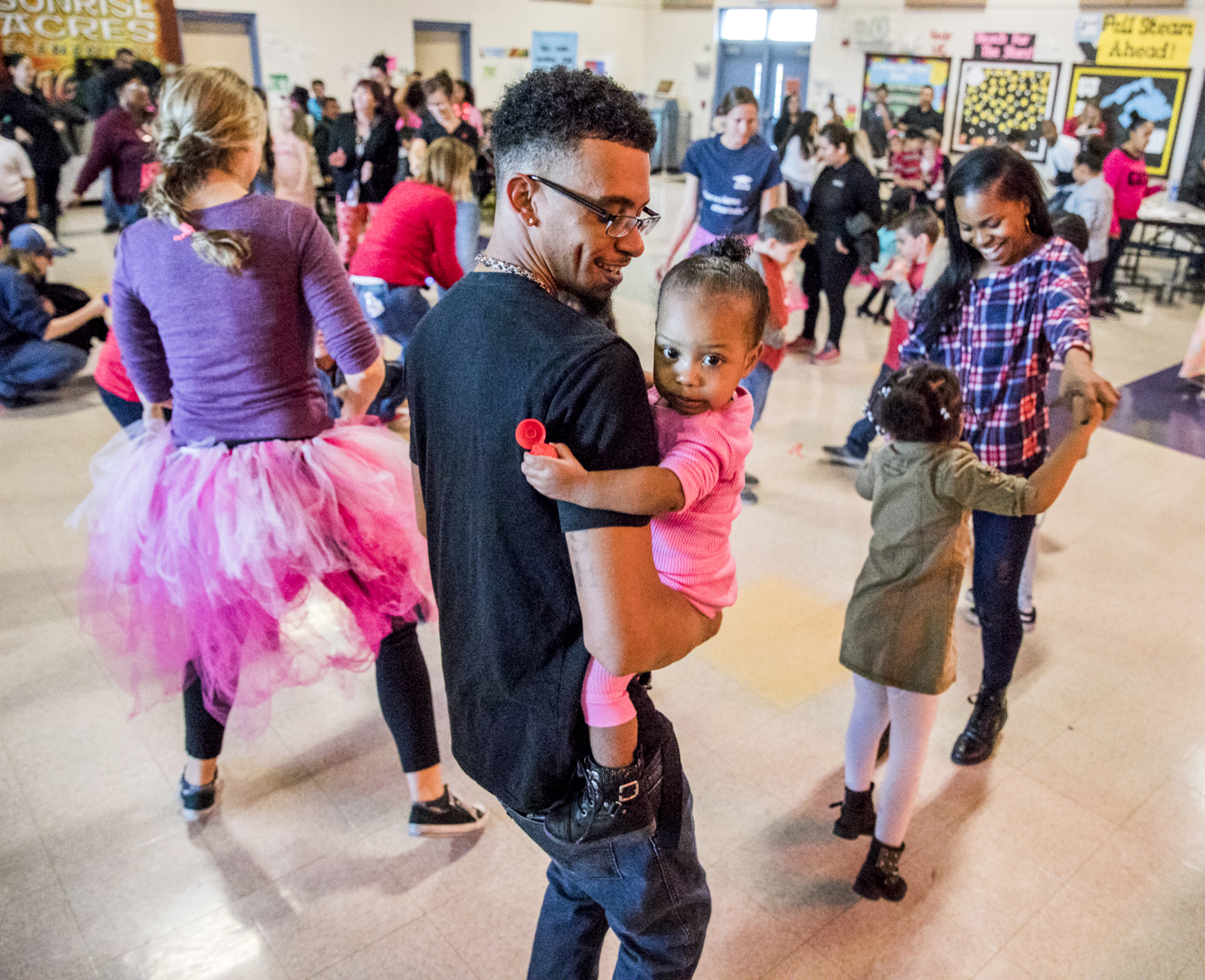
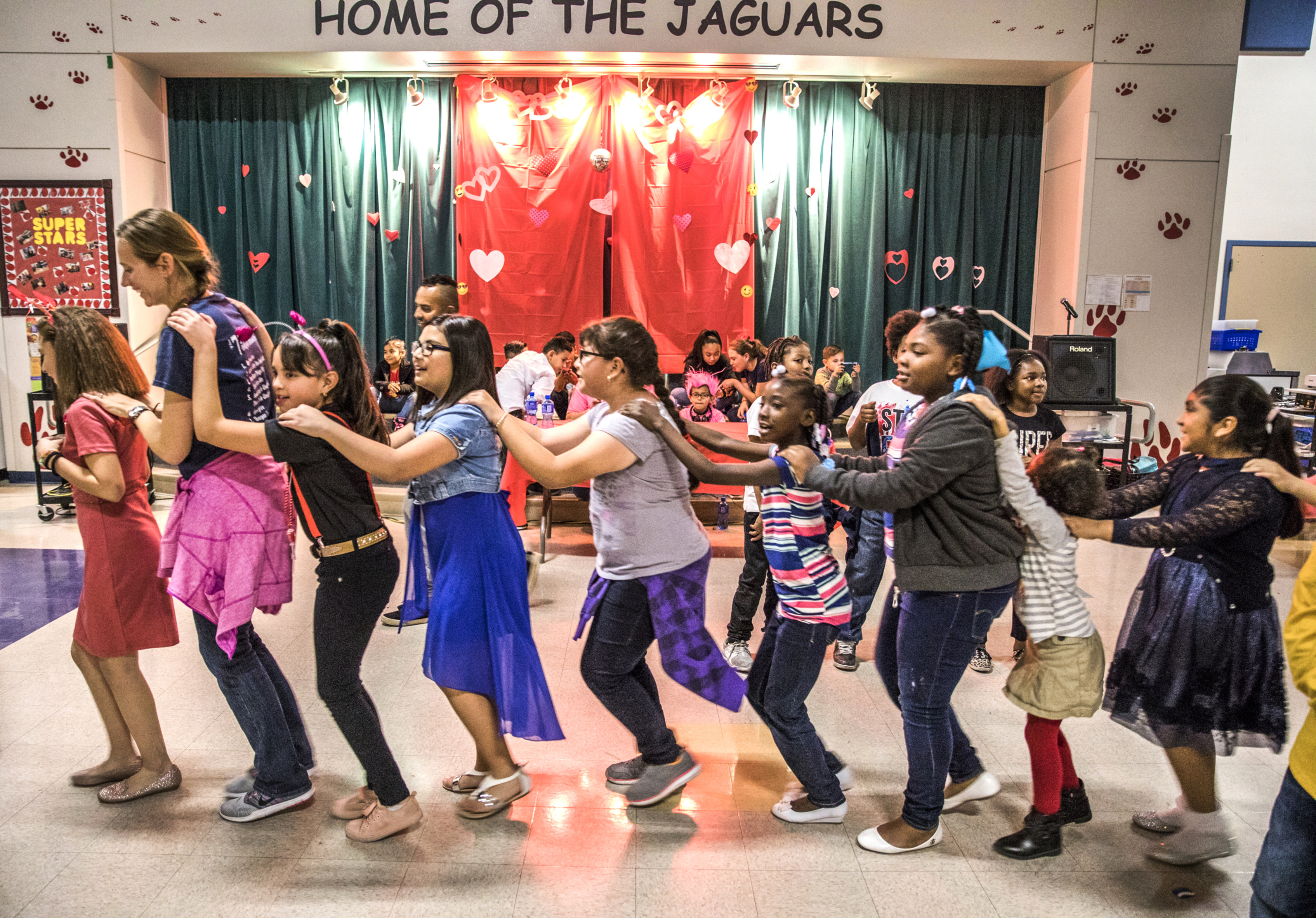
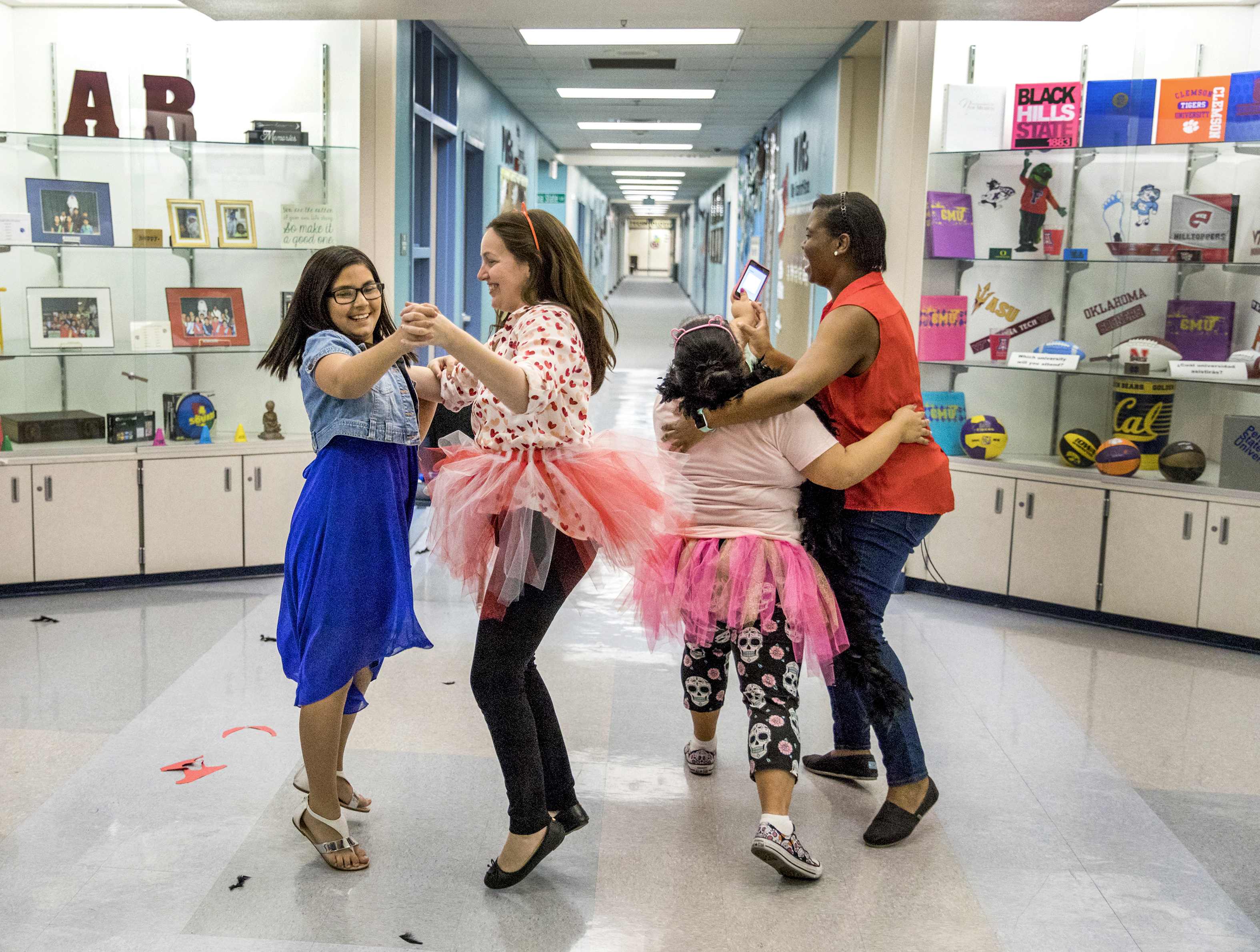
Top photo: Parents dance with their daughters during a Valentine's Day party in the cafeteria on Feb. 14, 2018. Middle: Physical-education teacher Desra Giancola leads a conga line during the dance on Feb. 14, 2018. Bottom: Fourth-grade teacher Melissa Tanner, left, and first-grade teacher Kinesha Manuel, right, dance with students in a hallway on Feb. 14, 2018.
Crunch time
Just after 8 a.m. on a Saturday in mid-March, 11 fourth-graders and two Starbucks-toting teachers occupy a dimly lit classroom. While others celebrate St. Patrick’s Day, this group has gathered for standardized test preparation.
Dubbed “SBAC Boot Camp,” the training session gives students who are on the brink of passing the Smarter Balanced assessment — the statewide test measuring students’ English Language Arts (ELA) and mathematics skills — a chance to hone their test-taking strategies.
Their materials: Chromebooks and scratch paper for notes.
Their task: Read three passages about animal friendships, answer questions and then write an original story about visiting a petting zoo and witnessing two animals that have a special bond. Aside from notetaking, all answers and writing must be completed on the Chromebook.
“It would be wise to try to take one note on each paragraph that’s really centered to our topic,” says Greer Perkins, a first-grade teacher helping run the three-hour session.
Her co-worker nods in agreement.
“Good point, Ms. Perkins,” fourth-grade teacher Nancy Valdes says as she wanders the room, checking on students’ progress. “I would do the same.”
About 70 third-, fourth- and fifth-grade students gave up a sleepy Saturday to prepare for the upcoming tests. There were no bribes. No rewards. Just an invitation given to select students whom teachers thought needed an extra boost to perform well on the tests.
The students’ drive to succeed doesn’t surprise Valdes.
“They want to do their best,” she says. “They have that mentality.”
The boot camp was one of several strategies the school employed as the all-important testing period approached in the spring. Teachers gave their classes practice assessments, staff filmed a video full of motivational messages for students and the school held a pep rally-style assembly right before testing began in late March.

The state transitioned to the Smarter Balanced assessment — often referred to as the SBAC — in Spring 2015. Technology glitches plagued the launch, rendering thousands of students unable to complete the new tests, which evaluate them based on Nevada Academic Content Standards and are considered tougher than the predecessor test. The standards, which reflect the federal Common Core criteria for ELA and math, emphasize critical thinking and analytical skills. In other words, it’s about applying knowledge rather than simply regurgitating it.
The computerized tests use adaptive technology, meaning the difficulty level of questions automatically adjusts based on students’ answers. The tests also include a “performance task,” which requires students to demonstrate research, writing and problem-solving skills.
Sound tough? Sunrise Acres teachers thought so.
Only three staff members earned a perfect score when they took a practice fifth-grade SBAC math test, Assistant Principal Michael Dobbyn says. The former fifth-grade teacher fell into the majority who answered a question or two incorrectly. The exercise bothered him.
“If I can’t show 100 percent proficiency on this, and most of our staff can’t show 100 percent proficiency, then how can we expect every question to be valid for our kids and that our kids can do well on this test?” he says. “I mean it’s almost impossible for them to be able to achieve that.”
Staff don’t necessarily discount the value of a standardized test. After all, the assessments measure students’ growth, or lack thereof, year over year and serve as an accountability mechanism. But if you ask educators like Dobbyn — who’s a testing skeptic — what they see as the problem, many point to the sheer volume of assessments.
Students in grades three through five take the SBAC tests. For third- and fourth-graders, that means four days of testing to complete the math and ELA sections. Fifth-graders, meanwhile, spend six days testing to complete the math, ELA and science sections. (Students can take all day to complete the tests if needed, but most finish within several hours.)
There’s also Measures of Academic Progress (MAP) testing, which students in kindergarten through fifth grade take three times a year. Those tests chart students’ reading and math growth over the course of the school year.
About half of Sunrise Acres students take another standardized test known as WIDA because they’re considered English Language Learners — the academic term used to describe children who speak a different language at home and enter school knowing little or no English. The WIDA test evaluates their mastery of the English language, which includes being able to listen, speak, read and write it.
Principal Margarita Gamboa, once an ELL student herself, says the WIDA testing essentially amounts to five lost days of instruction for every child because school staff carry out the assessments. What that means: Students don’t have their normal teacher for chunks of time as staff rearrange schedules and cover for each other to administer the WIDA tests during February.
On top of those standardized assessments, students take subject-specific tests given by their teachers. These are tests or quizzes for things like spelling or multiplication tables.
Sunrise Acres has winnowed the number of tests given in recent years, but Dobbyn estimates students still spend a fifth of the school year taking assessments in one form or another.
“I think that’s out and out crazy,” he says.
But it’s the education landscape that has become the norm for most American schoolchildren. Testing of students dates back to the late 1830s, according to the National Education Association, with standardized assessments ramping up since the turn of the millenium.
The test-heavy environment doesn’t necessarily bother Jeffrey Geihs, who oversees the district’s Turnaround Zone, a program to rapidly improve chronically low-performing schools. When he hears the term “teaching to the test,” which often carries a negative connotation, he envisions a classroom focused on increasing students’ math and reading proficiency levels as well as their ability to analyze information.
“If people want to say that’s teaching to the test, I have no problem with it,” he says. “Those are life skills.”
Either way, testing is what brought Robert Rosenblatt to a fifth-grade portable classroom in late March. As one of the school’s learning strategists, he’s an education coach, charged with helping staff employ best teaching practices in their classrooms. But with his booming voice and jovial spirit, Rosenblatt also assumes the role of student cheerleader ahead of testing season.
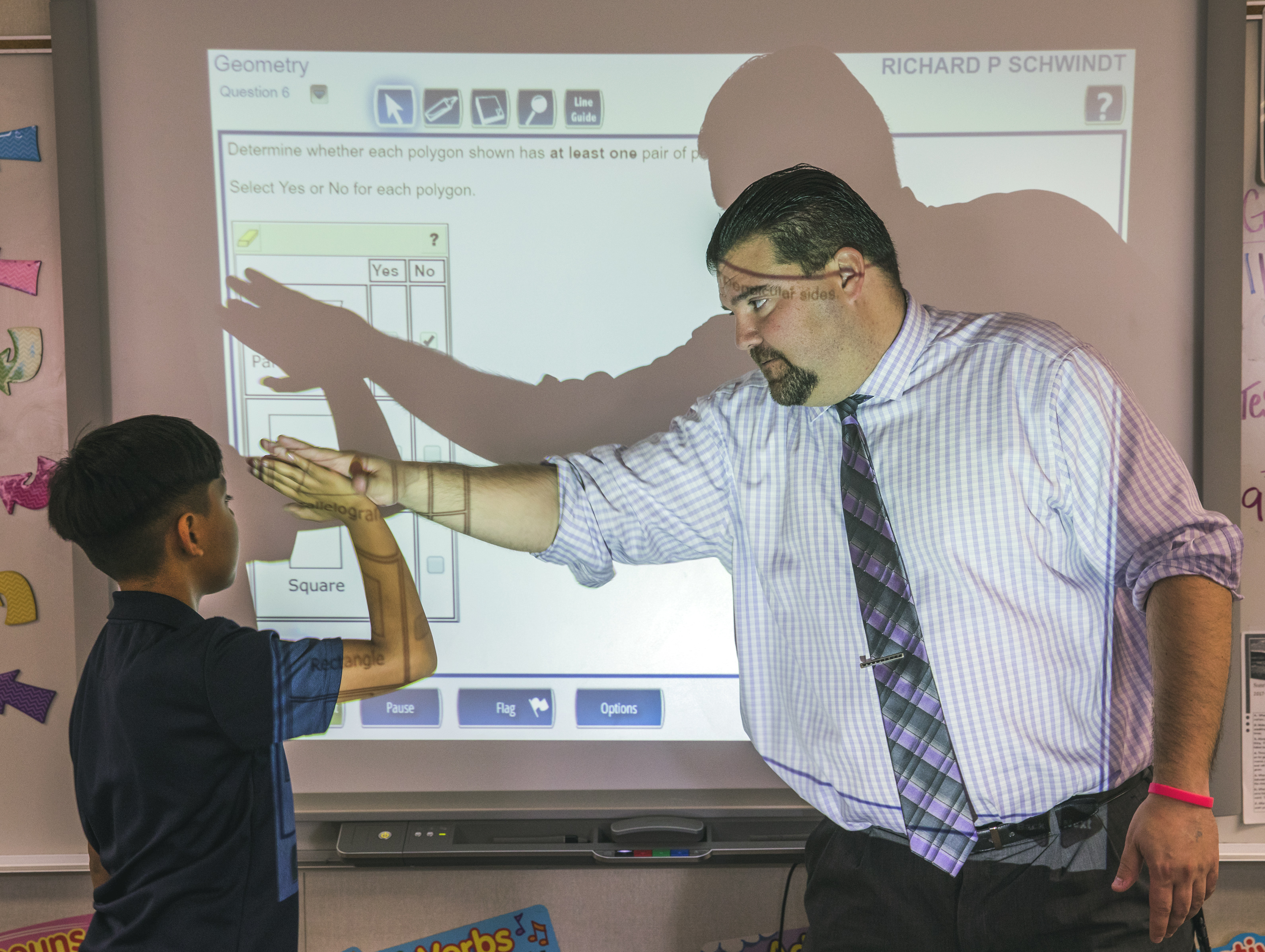
Part of the trick, he says, is making students believe in themselves. Test anxiety runs deep among some students, particularly those who exhibit perfectionist tendencies.
“What I want you to see by the time that we are done is that it’s actually going to be pretty easy,” he tells the fifth-graders eyeing him skeptically in their classroom.
Today’s practice drill is a geometry test, albeit not a sedentary one. Rosenblatt labels corners of the room A, B, C and D. Then he draws a question up on the smartboard.
“Please go to the corner of the answer you choose,” he says.
Chairs clank and shoes pound the carpet as students scurry to a corner. Most students wind up in corner D — the correct answer for a graphing question. The next question asks students to determine if the drawn polygons are a quadrilateral. Standing up means yes; sitting means no.
A girl, pausing after each word, carefully explains why she stood for a parallelogram.
“It’s a quadrilateral and a polygon because it has four sides and four angles,” she says.
“Yes! I loved the way you explained that,” Rosenblatt replies.
Several questions into the practice test, Rosenblatt asks what will become a rhetorical question: “Don’t you feel good about this?”
No one takes the bait, so he continues.
“Sometimes we pump you guys up about the big test and you get nervous. But you know this stuff. It’s not that bad.”
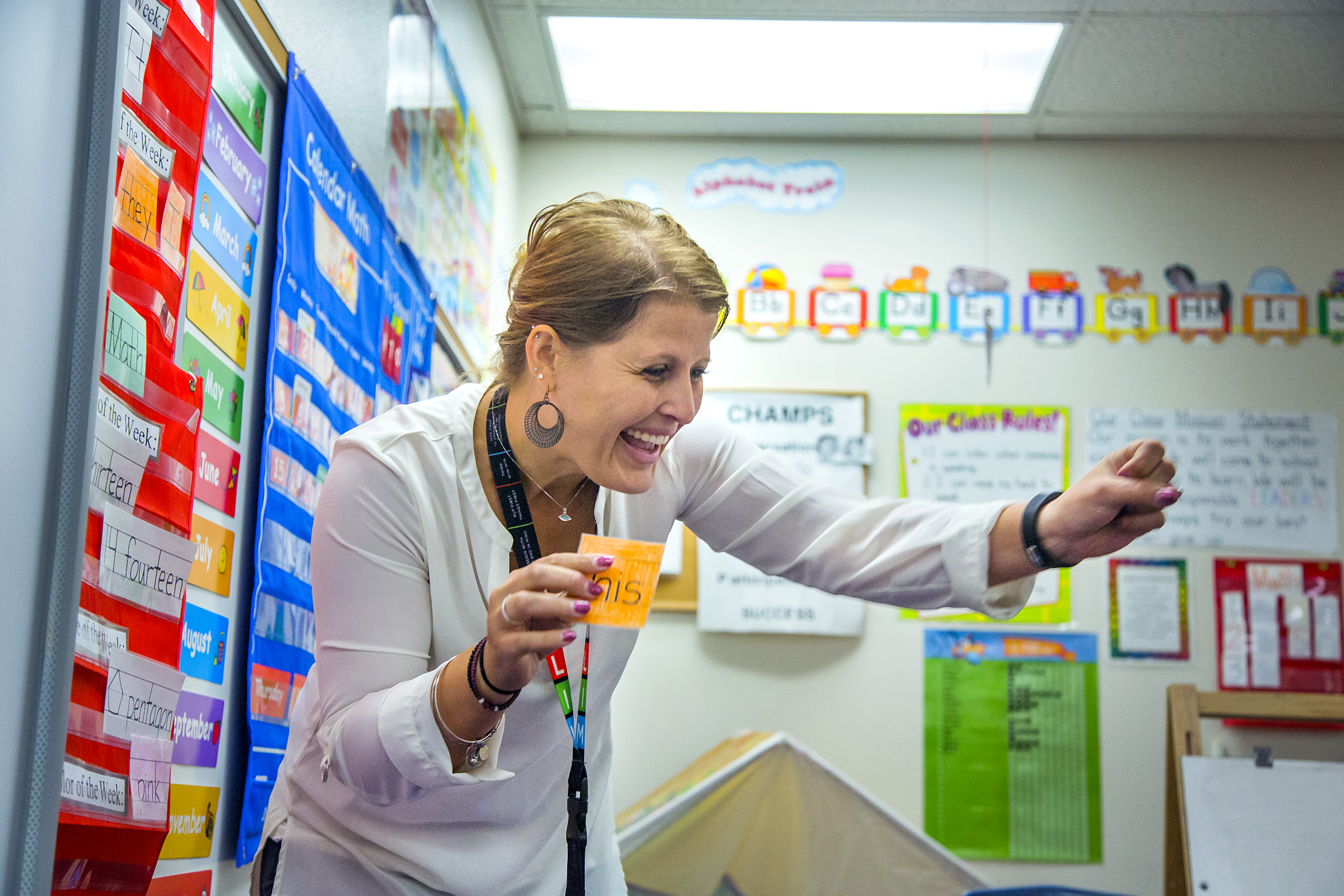
Little learners, big expectations
The scene inside the fifth-grade classroom, where students spouted well-reasoned answers to geometry questions, stands as a beacon of hope for teachers educating the school’s younger children. Many kindergarteners entering Sunrise Acres never stepped a foot inside a preschool classroom.
The school boasts morning and afternoon pre-kindergarten classes, but those 32 seats first go to students deemed low-performing academically. Plus, the transient nature of the neighborhood leaves no guarantee that the school’s pre-kindergarten students will wind up here the next year.
So kindergarten teacher Anastasia Stathopoulos doesn’t expect much when she meets her new students each August. Typically, she says, only two to three students — in a class of roughly 20 — enter knowing the full alphabet. Most know five to 10 letters.
“It’s like we have to start from scratch,” she says.
That doesn’t make the stakes any lower, though. Per Nevada content standards, students should exit kindergarten being able to recognize and write all the upper- and lower-case letters as well as pronounce the letter sounds. They also should know how to read high-frequency sight words such as “the,” “to,” “he,” “she,” “you” and “do.”
On the math side, it’s all about number and shape recognition and counting.
Stathopoulos blends the two as much as possible in her brightly colored classroom, where numbers and letters plaster the walls. Harnessing the movements of a musical conductor and the voice of a sports broadcaster, she welcomes her kindergarteners by reciting the date.
“Today is Thursday, October 19, 2017,” she says, pointing to a calendar.
The 5- and 6-year-olds repeat the sentence, giving their vocal chords a test in the process. If anyone wandering the hallway didn’t know the date before, they do now.
The palpable enthusiasm — little kids eager to learn and happy to be here — carries into their lesson of the day: the letter “T.” Stathopoulos walks them through “T” sounds and words before she sends them back to their desks to practice their penmanship.
Some clutch their pencils with ease; others struggle to find the right grip. The same is true when it comes to writing the letter “T.” Stathopoulos utters reminders and idioms:
“We start across and down,” she says, describing how to write the uppercase letter.
“Practice makes perfect.”
The 34-year-old stops by a boy whose worksheet contains pencil smudges and erase marks. He eyes the dotted line, where he’s supposed to write the letter, unsure where to begin. Stathopoulos guides his hand, forming the letter.
“It’s okay,” she says, drawing an impish smile from him. “That’s how you learn.”
Five months later, six of her 19 students can read 100 sight words or more. Only three students haven’t hit the kindergarten goal of mastering 50 sight words, but with a month of school left, she’s hopeful they’ll reach that milestone.
Stathopoulos says witnessing their rapid growth — from knowing only a few letters to reading several dozen words — is what makes the beginning of the year bearable.
“That’s why a lot of people say, ‘God bless you for teaching kindergarten,'’’ she says. “Because it’s hard.”
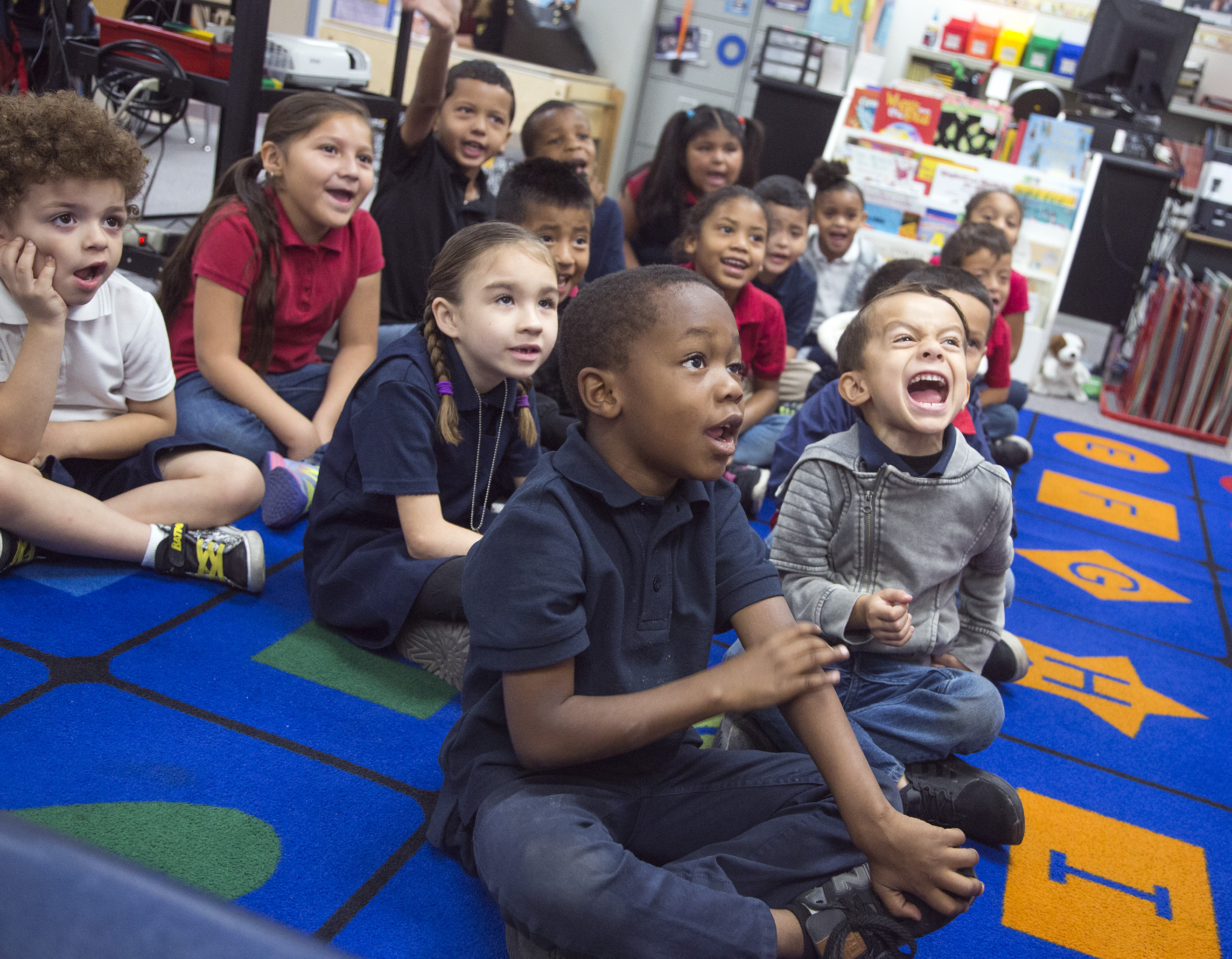
She’s grateful at least for a smaller class size. When Stathopoulos first started teaching at Sunrise Acres five years ago, she had 32 kindergarteners and no teacher’s aide.
Fewer students, however, doesn’t necessarily mean less pressure.
One of Republican Gov. Brian Sandoval’s signature education reforms has made her alphabet lessons even more important. The law known as Read By Grade 3, which went into effect in July 2015, is fairly self-explanatory: Students must demonstrate proficient reading skills by the end of third grade or face the possibility of being held back a year. There are several exemptions built into the law that would prevent retention — for instance, if a child has a learning disability, is an ELL student or can prove reading proficiency in an alternative manner. (Students’ reading skills will be assessed via the computerized MAP tests.)
Education officials says the measure isn’t meant to be punitive. They’ve hailed it as a way to better position students for future academic success. Research has shown that students who haven’t mastered basic reading skills by that age face continued struggles as they go up the education ladder.
First-graders in the 2017-2018 school year will be the first cohort subject to the new law. Teachers already are monitoring their reading progress on the MAP test, which they take three times a year. Come the end of third grade, they’ll need to be scoring above the 40th percentile mark on the computerized assessment.
Half of the school’s 130 first-graders are reading above that percentile mark on tests for their age group, says Luz Vasquez, who’s the designated reading learning strategist. Whether that number increases, decreases or remains flat as students age is the big unknown.
“Until these first-graders are in third grade, we’re not going to know how it’s going to go down,” she says.
Teachers don’t put that knowledge burden on students. They keep it positive with the children, she says, only sharing reading goals and progress. Parents receive a letter if their child slips below the 41st percentile on MAP reading tests, but even then, Vasquez isn’t sure they fully understand the potential effect of the new legislation.
Last year, when Vasquez was a first-grade teacher, no parents asked her about the law.
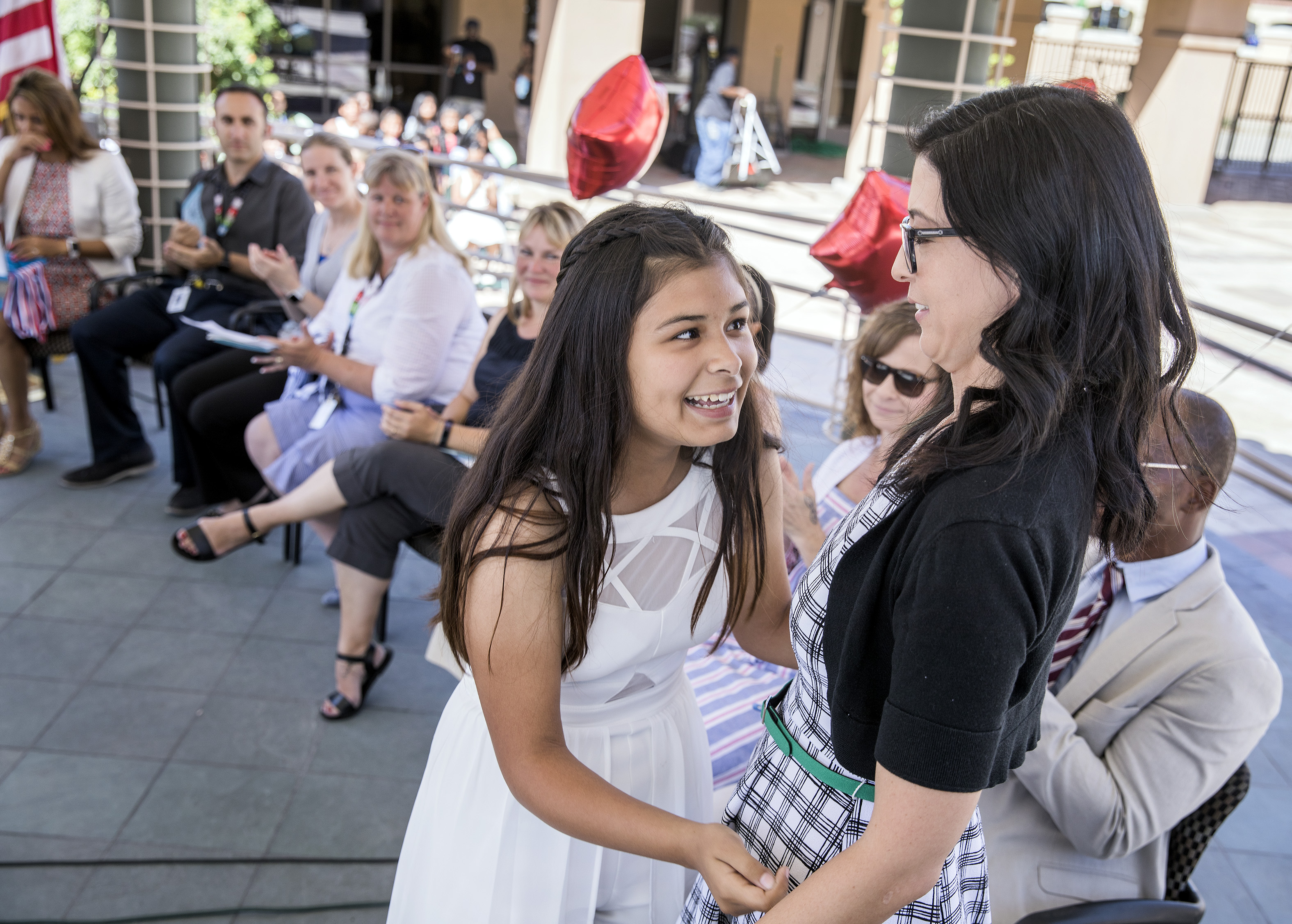
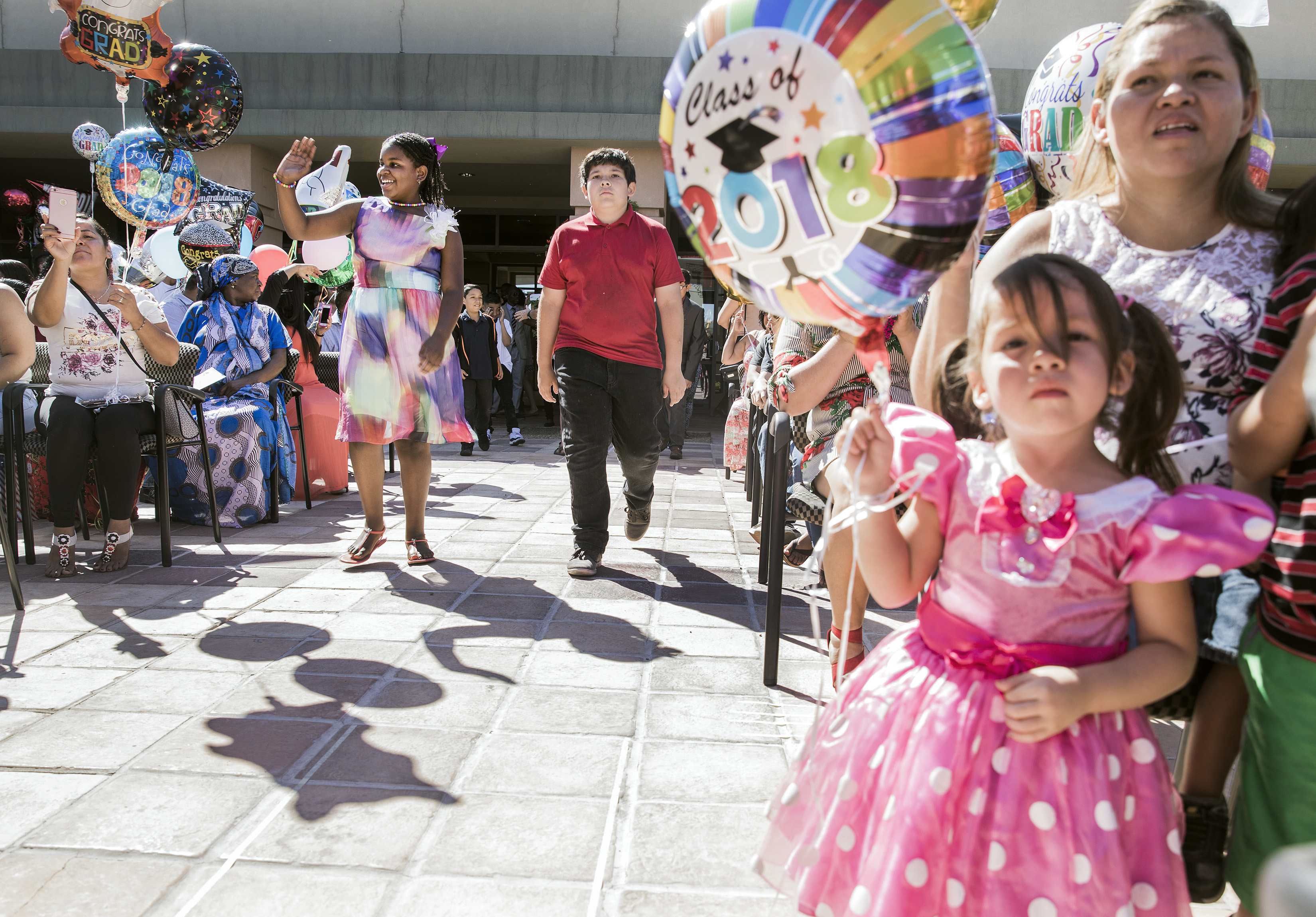
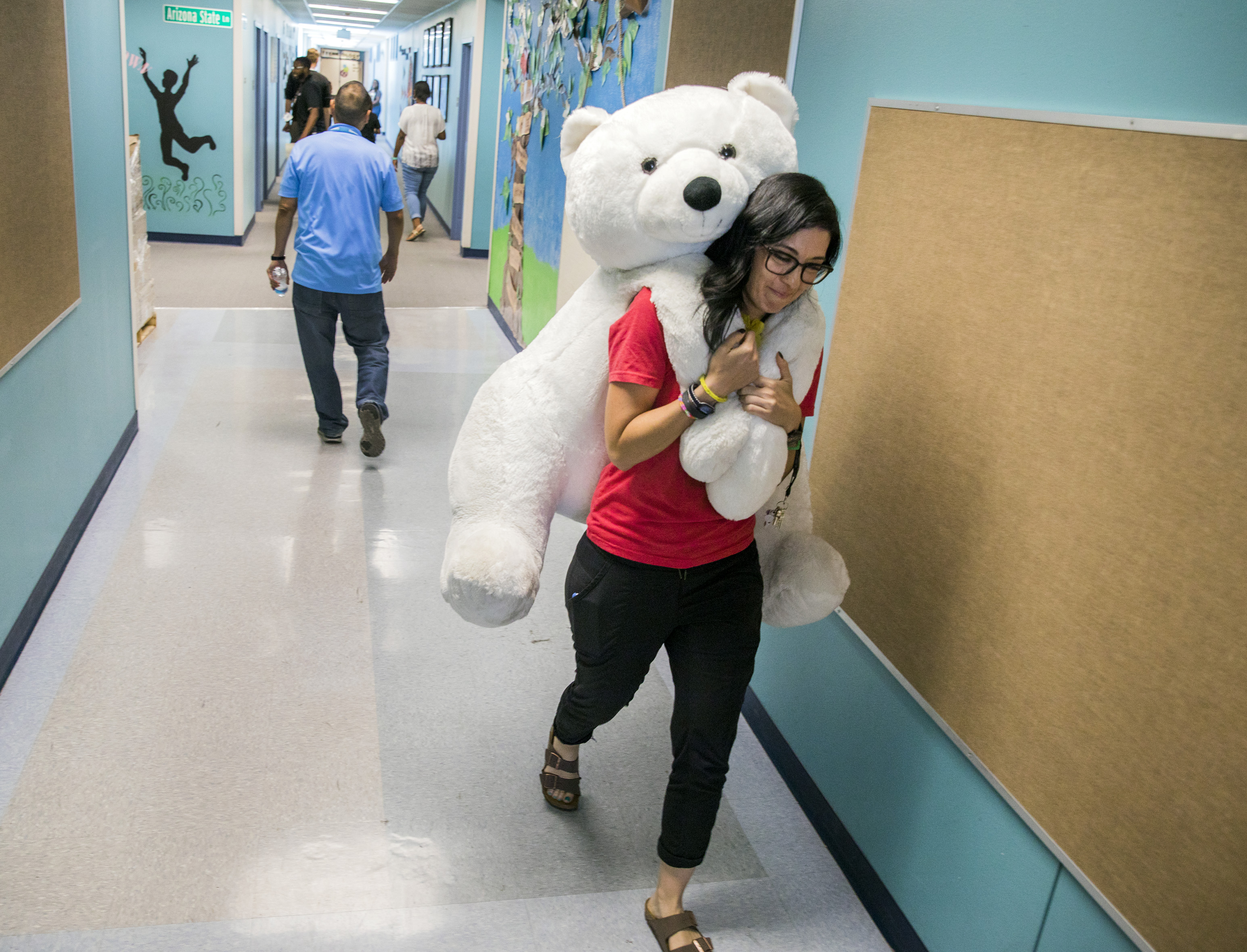
Top photo: School counselor Megan Gutierrez, right, gets a hug from "Ava" during a fifth-grade graduation ceremony at the East Las Vegas Community Center on May 24, 2018. Middle: Fifth-grade students walk past friends and family during a graduation ceremony at East Las Vegas Community Center on May 24, 2018. Bottom: School counselor Megan Gutierrez walks down the hallway with a stuffed bear on May 24, 2018. She's transferring to another school next year.
A school year ends
It’s a sunny, 81-degree day as fifth-graders file into the East Las Vegas Community Center, sporting dresses, button-down shirts and even a few ties. They form a line inside, with girls who dared to wear heels towering over their male classmates. And then they wait — maybe eagerly, maybe sadly or maybe both — for the processional music to start.
Today, they will walk across an outdoor stage, grab a medal and a certificate and bid farewell to their grade-school years. The promotion ceremony, as it’s called, comes a week after the students wrapped up their final SBAC test.
Now, a summer separates them from the next leg of their journey — middle school.
Their fun-loving learning strategist, Rosenblatt, tells them to visit.
“The door will always be open for you.”
Their principal, Gamboa, implores them to reach their potential.
“It’s not that we are born smart and it’s not the ZIP code that determines our success. It’s hard what?”
“Work!” the students shout.
But it’s a fifth-grader named Ava who brings the ceremony full circle. Wearing a long and flowing, cream-colored dress, she ascends the stairs slowly, careful not to trip. Then she looks out toward the family members clutching balloons and smartphones.
Tears stream down her face.
The straight-A student, who struggles to earn validation from her single father, is supposed to introduce the next speaker. Instead, she glances back at Megan Gutierrez, the school’s beloved counselor who’s moving to a middle school next year as well.
“Hey guys,” Ava says, steadying her crackled voice. “I would like to say thanks to Miss G because Miss G, she has changed my life, and I’m certain she has changed many of yours.”
The stunned, and now emotional, counselor dabs her eyes as Ava continues.
“Thank you for always believing in me when I didn’t believe in myself.”
The girl’s surprise speech, in a sense, conveys more than the adults’ carefully crafted words. Because the last day of school is about more than celebrations and congratulations.
It’s also about gratitude and goodbyes.
Epilogue
On a hot day in late June, Principal Margarita Gamboa packs the items filling her Sunrise Acres office. The family photos. The education books. The mementos she has received over the last six years.
She, too, will be saying goodbye to the elementary school — the place her education journey started as a kindergartener and where, decades later, she returned as principal.
But a new challenge beckons about five miles south. Gamboa has been selected to become principal of Harris Elementary School, an aging building that sits just west of Interstate 515.
“I know tomorrow, once I get my last box out of my office, it’s just going to be tough,” she says on June 21.
Gamboa considers this building on North 28th Street her home away from home. After all, it’s her childhood school in the neighborhood she grew up. As principal, she shepherded the once-failing school through a dramatic transformation that culminated with a new four-star rating. Now, she hopes to do the same at Harris Elementary School, which district officials entered into the Turnaround Zone this spring.
What that means: The struggling school needs help.
But no sitting principals applied to become the one-star school’s next leader.
Gamboa says she inquired about the Harris position after noticing two internal job postings. She had a hunch that no one wanted the position.
One thing led to another and, before long, Gamboa found herself in an interview with the school’s organizational team. District officials offered her the job June 19. It will be her second time ushering a school through the turnaround process. The first was Sunrise Acres.
Her mission will be identical: Turn Harris into a three-star elementary school within three years.
“I think we can do it sooner, honestly,” she says. “It has great potential.”
The new challenge doesn’t make leaving Sunrise Acres any easier. Gamboa says she approached the new job possibility with the same mindset she did when applying to Sunrise Acres: If it’s meant to be, it will be.
The job offer came. She accepted. And then she penned a goodbye letter to her Sunrise Acres staff and community, thanking the team for the last six years. She saves the final sentences to talk about the children.
“Please give them a hug for me and let them know how they touched my heart and life,” she wrote. “I treasure my memories of them all.”
A new principal for Sunrise Acres has not been named yet.